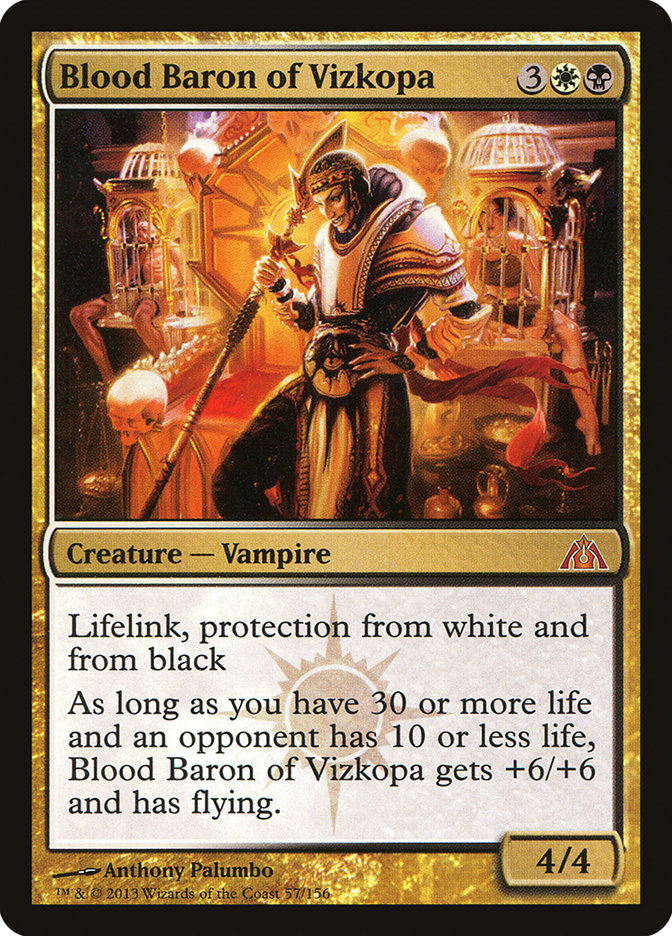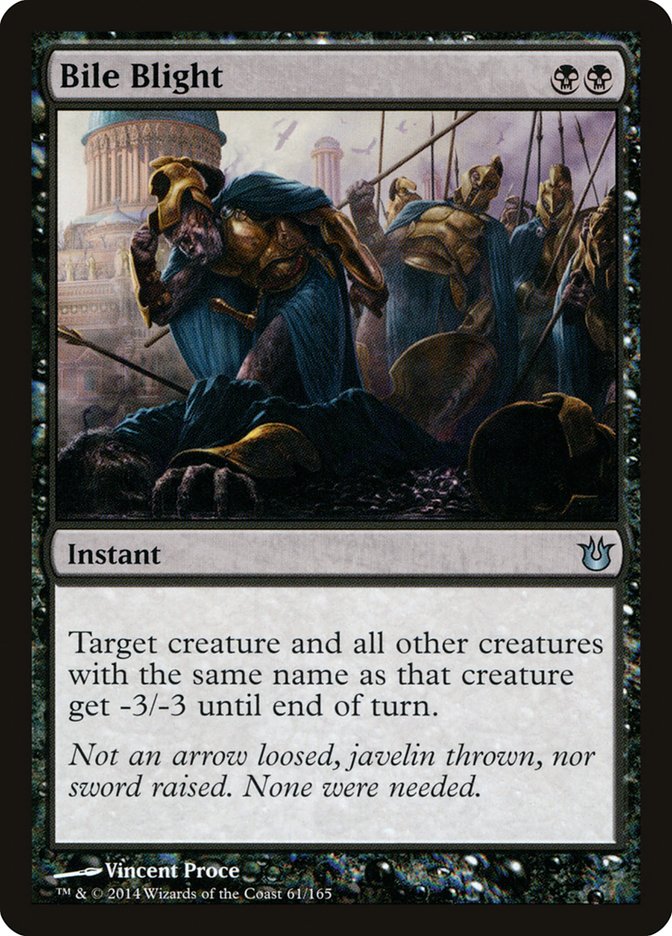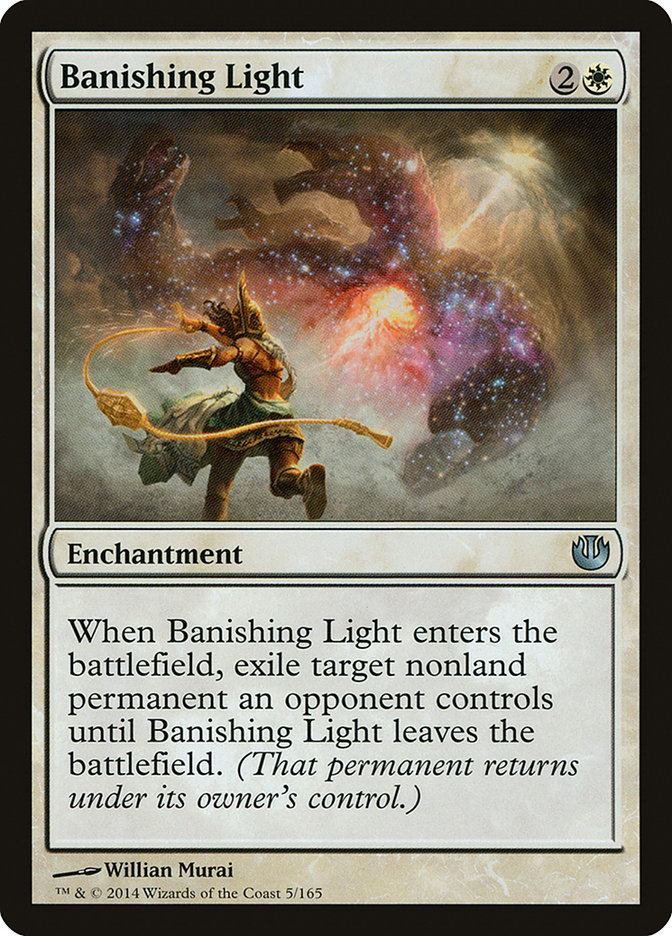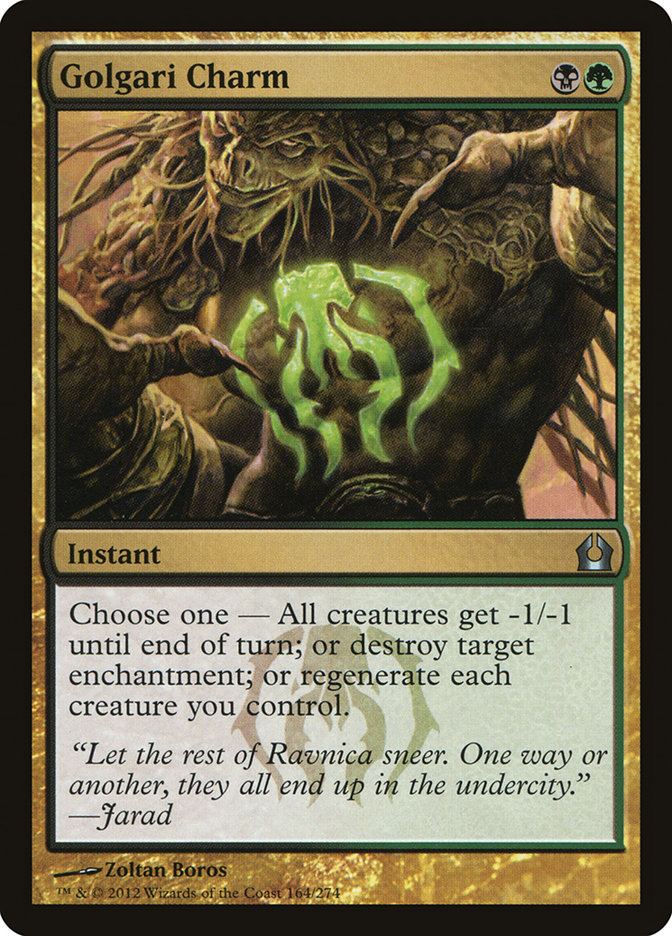Going into testing, my guess was that the place to be was a Thoughtseize Black deck of some variety, but that testing would involve a lot of exploring of
new concepts to see if something rose head and shoulders above the rest.
The Monday a week and a half before the PT, I met up with William “Huey” Jensen, Owen Turtenwald (The Kid), Reid Duke, Sam Black, Jelger Wiegersma, Jamie
Parke, Matt Costa, and Andrew Cuneo. We had a cabin in the scenic mountains of Government Camp, an hour and a half outside of Portland. That Friday, we
were to be joined by Paul Rietzl, Jon Finkel, Zvi Mowshowitz, Tom Martell, Gabriel Nassif, and Gaudenis Vidugiris.
Early into testing, one brew garnered special attention. Huey had thrown together a list he had sketched out that set to work maximizing Obelisk of Urd,
naming Soldier. After a bit of tweaking, the list ended up looking something like this:
Creatures (22)
- 4 Dryad Militant
- 4 Precinct Captain
- 2 Azorius Arrester
- 4 Boros Elite
- 4 Soldier of the Pantheon
- 4 Brimaz, King of Oreskos
Lands (22)
Spells (16)

The biggest point of contention was whether Azorius Arrester was the next best two-drop option, or if they should go back to being Imposing Sovereigns.
Spear of Heliod and Hall of Triumph were both options as well with one copy of Launch the Fleet as a possible cut.
Sam, Reid, and I were trying lots of speculative lists as we always do. Meanwhile, Andrew worked on his U/W Control list and The Kid tuned his B/g Devotion
deck. This left Jamie, Costa, and Jelger, who all really stepped up to the plate, volunteering to build and play the stock decks and rip our brews to
shreds. One vital component to the success The Pantheon has enjoyed has been the willingness and desire to play the stock decks to the fullest, to provide
the absolute most ruthless tests possible to cull the weak brews from that rare one or two that can stand up to the gauntlet.
I tried a variety of lists; some only medium levels of embarrassing, some the full amount. The first that actually looked like it had serious potential was
Slivers. My first draft had Belligerent Sliver and a couple random one-ofs, but a little tuning brought me to here:
Creatures (32)
- 4 Blur Sliver
- 4 Striking Sliver
- 4 Thorncaster Sliver
- 4 Predatory Sliver
- 4 Galerider Sliver
- 4 Manaweft Sliver
- 4 Diffusion Sliver
- 4 Venom Sliver
Planeswalkers (1)
Lands (24)
Spells (3)

While my original list was a little more random, the tuned version ended up moving close to some of the lists Tom Ross has been working on lately. He has
been making a lot of really good decks lately, particularly his red Heroic decks (which have improved with the addition of Hammerhand, Frenzied Goblin, and
Stoke the Flames).
This style of Sliver deck really revolves around Venom Sliver. Combining it with Striking Sliver creates a soft creature lock, making it difficult for
normal decks to attack or block. If you can ever set up Thorncaster Sliver + Venom Sliver, you usually just win on the spot. Meanwhile Predatory Sliver and
Galerider Sliver are just super effective at what they do, helping you take over the games you don’t have Venom and locking up the air as well.
If you only play three colors, I think RUG is the natural color combination, as Striking Sliver and Galerider are the only legal one-drops, and green
brings three excellent two-drops to the table. We’ve already touched on Venom and Predatory, but Manaweft is also very potent. Not only does it smooth out
our mana, it also leads to some pretty sick openings involving Blur Sliver + Manaweft Sliver to empty your hand, or just using Manaweft to power out the
quick turn 3 or 4 Thorncaster Sliver.
Early on, the list smashed Mono-Blue Devotion 8-2 and went 6-4 against Owen’s B/g deck, generating a bit of excitement. We knew U/W Control would be hard,
but depending on how that went, Slivers looked like it could be a real thing.
As expected, U/W Control was hard, but maybe we could just take that as a loss? Jace, Architect of Thought was just devastating (increasing our reliance on
Obelisk of Urd). Unfortunately, with more testing, it started to look like the Mono-Blue Devotion matchup wasn’t quite as good as our first set suggested.
As sweet as Slivers was, it looked like it was probably just a worse Soldiers deck.
I spent a little time experimenting with other takes on Slivers, including this list, designed to help educate us on the various strengths and synergies of
the Slivers across the colors:
Creatures (35)
- 3 Bonescythe Sliver
- 3 Blur Sliver
- 2 Sentinel Sliver
- 4 Striking Sliver
- 1 Thorncaster Sliver
- 4 Predatory Sliver
- 4 Galerider Sliver
- 3 Syphon Sliver
- 4 Manaweft Sliver
- 2 Sliver Hivelord
- 3 Diffusion Sliver
- 2 Venom Sliver
Lands (25)

The most impressive white or black Sliver was definitely Syphon Sliver. I wasn’t sure how best to fit him into the RUG Sliver deck, but it was so good I
think you might have to. Maybe a manabase along the lines of:
Sliver Hivelord is sweet, but I was never able to find a balance between it and Mutavault, and Mutavault was generally the best card in the deck. I don’t know that you have to choose, but if you do, it’s not close. Counting on Manaweft is not safe, as that one has such a bull’s eye on its head, and
if it lives, you are generally rocking and rolling anyway.
One area I didn’t spend as much time on but may have potential is the Chord of Calling style of Slivers deck. That is such a slower and expensive way to do
things, but I could imagine a world where it’s worth it. We just need to be careful not to get too fancy. Part of what makes the Sliver deck work is how
fast and efficient it is.
Core sets have a special relationship to rotations, being legal for fifteen months but having interactions with the previous core set and block for just
three months. This means there is potential opportunity for some overpowered synergy that will only be legal for three months. For instance, Obelisk of Urd
capitalizes on the temporary abundance of Soldiers in the format, and Slivers capitalize on the temporary overlap between both sets with Slivers.
One “temporary interaction” that demanded exploration is the combination of Generator Servant + Kalonian Hydra. Kalonian Hydra is the perfect creature to
combo with the Servant not only because of costing five (making it a perfect curve), but also because Generator Servant granting haste has substantial
extra value with creatures that have an attack trigger. For instance, if Inferno Titan was legal, it would work exceptionally with Generator Servant.
Kalonian Hydra usually kills on turn 7 if it is cast on turn 5. When you combine Generator Servant with Kalonian Hydra’s attack trigger, you are now
looking at a turn 4 kill. That is a pretty dramatic difference–a Black Lotus worth of speeding up.
Creatures (27)
- 4 Exava, Rakdos Blood Witch
- 4 Elvish Mystic
- 4 Kalonian Hydra
- 4 Sylvan Caryatid
- 2 Stormbreath Dragon
- 1 Xenagos, God of Revels
- 4 Genesis Hydra
- 4 Generator Servant
Planeswalkers (4)
Lands (24)
Spells (5)

In looking for a home for the Generator Servant + Kalonian Hydra, Jund Monsters felt like the most promising starting point. Exava, Rakdos Blood Witch is
an underrated card anyway and is another mondo combo with Kalonian Hydra (not only giving the Hydra haste, but boosting Exava to a 5/5 right away). Hammer
of Purphoros and Xenagos, God of Revels were two more attempts to fit as much haste into the deck as possible.
Genesis Hydra was the eventual answer to “another creature with +1/+1 counters for Exava and Kalonian Hydra,” as well as something sweet to sink mana into.
I had started with a bunch of Soul of Shandalars given how good it was looking in a W/R Midrange deck I had been working on. The way the games played out,
the activated ability was an incremental sort of advantage, while Generator Servant decks are more of an all-in haymaker sort of strategy. We are not
playing small ball in the slightest. Having the extra burn spell in our graveyard wasn’t doing enough to actually decide games.
The W/R Midrange deck in question looked like this:
Creatures (15)
Planeswalkers (6)
Lands (27)
Spells (12)

This deck looked promising against Mono-Black Devotion and could easily sideboard enough high impact to make the Mono-Blue Devotion matchup appealing.
Unfortunately, it was just too bad against Revelation decks, not to mention having some natural weaknesses against stuff like Stormbreath Dragon.
After many experiments and seeing the sorts of things other people were trying, it was looking more and more like the format wasn’t going to change much
and that most new things fell into two categories:
● Enemy painlands enabling more and better manabases
● Hyper Aggro decks had many meaningful additions and would be a larger percentage of the field than before. This included Obelisk of Urd, Raise the Alarm,
Hammerhand, Frenzied Goblin, Stoke the Flames, Slivers, and more options for two and three-color aggro decks with very low mana curves.
A few cards that had really stood out to me were:
All four of these cards really overperformed, and I wondered if there was a Junk deck that could take advantage of them. Blood Baron may be vulnerable to
Lifebane Zombie, but at least topdecking it really was game often. People seemed to be playing less Devour Fleshes than they had been playing, and it
seemed to be one of the best ways to gain percentage against black decks.
Bile Blight being so effective against Nightveil Specter and Pack Rat was nothing new, but the surge of hyper aggro decks looked like it would really
benefit Bile Blight. I also thought Jund Monsters was overrepresented at the Open Series, and that the PT would be more focused on decks with less fatties.
Banishing Light’s stock goes up once you believe the world will have less Jund Monsters decks than The Open Series suggests. It is a reliable way to deal
with Nightveil Specter and Desecration Demon that also hits Underworld Connections (one of the few cards that matters in black matchups). It is also one of
the best removal spells against Mono-Blue Devotion and is a removal spell that isn’t completely dead against control. It even gives decks outs to Obelisk
of Urd that wouldn’t normally have them.
Finally, Golgari Charm was very appealing because of just how great all three modes (big surprise) are. The regenerate all creatures mode was among the
best anti-Supreme Verdict cards out there and ensured you could generally always get a card out of the Charm. Destroying an enchantment is great against
all the big decks, hitting Detention Sphere, Underworld Connections, Bident of Thassa/Domestication, Chained to the Rocks, and Courser of Kruphix. Finally,
the ability to sweep was great against most of the best decks: hitting Master of Waves, Soldier tokens, and a turn 2 Pack Rat.
I tried some more controlling builds focusing on Courser of Kruphix and Underworld Connections, but the more I played, the more it felt like you either
wanted to be very aggressive, or you wanted to just be a normal black deck. Reid Duke made some pretty solid upgrades to this style of Junk deck, utilizing
cards like Nissa, Worldwaker and Garruk, Apex Predator, with Blood Baron on the white splash. Eventually, however, he concluded that it just wasn’t better
than a normal black deck.
I experimented a bit with Junk Aggro (and G/W Aggro), trying to incorporate all of the cards I was liking (which obviously also includes Thoughtseize).
Creatures (18)
- 2 Loxodon Smiter
- 4 Voice of Resurgence
- 4 Blood Baron of Vizkopa
- 4 Fleecemane Lion
- 4 Brimaz, King of Oreskos
Planeswalkers (1)
Lands (24)
Spells (17)
- 4 Thoughtseize
- 1 Abrupt Decay
- 2 Selesnya Charm
- 2 Golgari Charm
- 2 Hero's Downfall
- 2 Bile Blight
- 4 Banishing Light
Sideboard

This approach was effective against control and Mono-Blue Devotion but struggled against black decks. Blood Baron of Vizkopa was an attempt to make up for
this, but at the end of the day, no single card matters very much in the black matchups. Everything gets canceled out by so many other things. One thing
that was clear, however, was that not playing Pack Rat was ludicrous.
Part of what makes Pack Rat so crazy is the interaction with Mutavault. I’m sure there are some decks out there that use Pack Rat with less than four
Mutavaults, but once you start down the Pack Rat path, there is nothing you want more. Trying to fit Mutavault into the above deck really pressured me to
cut a color. Of the cards I was liking most, Golgari Charm, was the only one I’d have to ditch to play two colors.
I tried a variety of B/W decks, basically starting from various manabases that were possible and then seeing what a deck with that manabase might be able
to do. For instance, one day I was curious if it was possible to play Precinct Captain and Nightveil Specter in the same deck now that Caves of Koilos was
legal.
Creatures (19)
Lands (25)
Spells (16)

This list was promising and a frontrunner for me in the last few days. It performed well against black decks and was better at fighting Mono-Blue Devotion
and control than our more traditional B/W Midrange deck. Unfortunately, it really suffered against green decks, and there were some stability issues that
lowered my confidence, despite reasonable results in testing.
Part of the problem was that in matchups where some of the more exotic choices were helping, often, nothing mattered, because things were so warped around
Pack Rat, or Underworld Connections, or Sphinx’s Revelation, or whatever. With so many games, so many matchups that seemed to fall into “almost nothing
mattered,” playing a more consistent manabase would certainly serve as a tiebreaker if there were two options I was unsure of.
Hall of Fame elect Paul Rietzl spent a couple days working with various black decks, thinking about their construction and what direction felt like the
best way to proceed. His intuition was that we didn’t have enough confidence in any of the deviations but could identify weaknesses in them. He thought we
should be focusing on tuning “traditional” B/W Midrange. After all, its biggest weakness before had been its manabase, and now we had access to Caves of
Koilos.
Rietzl is the player I have seen eye-to-eye with lately on deck choice, and his strengths as a pragmatist, a realist, are a nice counterbalance to my
outside the box and bold experimental deck explorations. There is no harsher critic of my experiments than Rietzl, and when he likes one of my decks,
that’s usually a really good sign that the deck is actually there. This time, however, he wasn’t into my list. With three days of testing left, I decided
to abandon the crazy stuff and just focus on tuning “stock W/B,” in somewhat the same vein as our Pro Tour Theros deck from last year.
Owen had been on B/g for most of testing, having concluded that it was strictly better than mono-black. He had been initially cool off white, not wanting
his Blood Barons to get Lifebane Zombied, but he is an extremely rational and logical strategist that cares more about finding the truth than holding onto
his initial views. Owen and Costa started from the side of just splashing Blood Baron in Mono-Black, replacing Gray Merchant of Asphodel, while Rietzl,
Jamie, and I came from traditional side of the spectrum. Martell was also an early adopter, not liking any of the other team decks.
Huey had been on U/W Control (as a fallback) but thought the chances were high he’d play Reid’s deck if he ever said it was good enough, or the same deck
as Owen if enough people were all into it and it made sense to him. Finkel had tested a bit with everything and was also resigned to playing a black deck.
Given that more than half the team was on the same list, he focused on that one. While several people changed a card, here is the basic list that Rietzl,
Owen, Huey, Reid, Costa, Jamie, Tom, Jon, and I played at the Pro Tour:
Creatures (14)
Planeswalkers (2)
Lands (26)
Spells (18)

Sam Black, Zvi Mowshowitz, and Gaudenis Vidugiris also played a B/W Midrange deck, though it was a more exotic take that had begun as a Return to the Ranks
synergy deck but ended up basically just another B/W Midrange deck with Brimaz, King of Oreskos and Precinct Captain (not that that is a standard archetype
by any means, but that basically sums up the deck). Sam will surely be breaking down his B/W deck in this week’s article.
While I Day 2’ed, I ended up outside the money after going 3-3 in draft and ending up on the wrong side of Thoughtseize/Pack Rat a couple times too many. I
always like to identify what I could have different in games that I lose at PTs, but for this PT, literally 100% of my losses involved mana screw
or Pack Rat, as did most of my wins. No complaints, I knew what I signed up for. I still think it was the right choice for the field, and I am super proud
of Owen Turtenwald and William Jensen for their top 8s. Sometimes the best players top 8 too!
Major props to Matt Sperling, as well. Sperling has long been on the shortlist of best players without a PT top 8, but he just crushed this weekend. This
wasn’t Pat Cox’s first top 8, but it was overdue and long deserved. Cox has been one of the most underrated players over the past couple of years, so it
was great to see him step up with the archetype he helped put on the map, Brave Naya.
The Pro Tour was an absolute blast, and Portland is an incredible city. It’s hard to go back to ending a Pro Tour on Saturday instead of Sunday, but I am
already counting the days to Pro Tour Khans of Tarkir in Honolulu. Hawaii is my favorite place on Earth, and there is no sweeter time for brewing than
after a rotation.
I’m out for this week but will be back Monday. All Standard PTs? What does that mean? What sorts of technology will WotC use to ensure that the format
stays fresh and dynamic? Why is WotC doing this when it looks like Modern has been doing so well?
Spoiler: Modern is doing incredibly well, and there will be many Modern GPs. Every Modern Pro Tour was basically locked into involving bans to keep it
fresh and interesting. Modern is beloved by its base as it is, so what if instead of banning more cards, we just let people play the format as it is for a
while? Besides, Modern doesn’t showcase the new set which is a primary function of the Pro Tours. Modern is very successful and will continue to grow.
See you Monday!
P.S.- Why didn’t I play a brew? When your top priority is winning, you have to be able to play a stock-ish deck if it’s the deck that gives you the best
chance of winning. Being locked into having to play brews is a real weakness.




